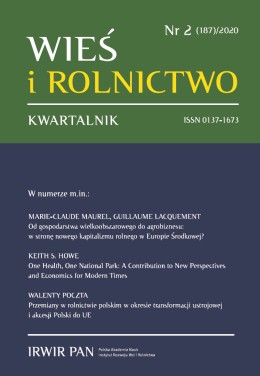Changes in Polish Agriculture in the Period of Political Transformation and Accession of Poland to the EU
DOI:
https://doi.org/10.53098/wir022020/03Keywords:
political transformation, Poland’s accession to the EU, the agricultural sector, structural changes in agriculture, changes in the production and income situation of the agricultural sectorAbstract
Last year marked the 30th year of Polish political transformation and 15th year of Polish membership in the European Union. Both processes, i.e. political transformation and European integration are closely connected, as the condition for Polish accession to the European Union was prior progress of the political transformation process. One sector that was significantly affected by the transformation process was agriculture. One of the characteristics of the economies of post-socialist countries was their “agrarisation”. The excessive role of agriculture was reflected in the sector’s contribution to labour resources and GDP generation. Transformation in Poland, similar to in other countries, resulted in radical changes in the structure of the national economy and remained in close cause and effect relationships with the processes of allocation of production resources and changes in economic conditions of farming (resulting mainly from price relations shaped by the market and freedom of economic exchange with foreign countries). In the first years of transformation, there was also a privatisation of the state sector in agriculture and the process of structural changes in individual agriculture began. Poland’s accession to the EU accelerated the changes that began in the first years of the political transformation, but at the same time the support and protection of these changes from public funds (from the EU budget) was radically increased. After the accession, the process of freeing the agriculture from inefficient labour resources continued, but it was slow and did not occur in every year. The inclusion of Polish agriculture in the EU CAP created conditions for an increase in production and, above all, in farming income. Supply-side capacity was significantly aided by transfers from the EU budget. Growing investment outlays, resulting from the inclusion of agriculture in the measures of the second pillar of the CAP, made it possible to halt the processes of decapitalisation of fixed assets in agriculture and enabled the modernisation of developmental farms. The demand side was influenced by the participation in the Single European Market, especially by the dynamic growth of agri-food exports. These processes have improved the production and income situation in agriculture. The value and volume of agricultural production, especially agricultural incomes, have increased, to a large extent thanks to subsidies received by Polish agriculture for its participation in the CAP.
References
Aslund A., Orłowski W.M. (2014). The Polish Transition in a Comparative Perspective. Warszawa: mBank – CASE Seminar, Proceedings, 133, CASE.
Baer-Nawrocka A., Poczta W. (2016). Polskie rolnictwo na tle rolnictwa Unii Europejskiej. W: J. Wilkin, I. Nurzyńska (red.). Polska wieś 2016. Raport o stanie wsi (s. 81–106). Warszawa: Wydawnictwo Naukowe Scholar.
Baer-Nawrocka A., Poczta W. (2014). Przemiany w rolnictwie. W: I. Nurzyńska, W. Poczta (red.). Polska wieś 2014. Raport o stanie wsi (s. 85–124). Warszawa: Wydawnictwo Naukowe Scholar.
Blohm G. (1961). Ekonomika i organizacja gospodarstw rolniczych. Warszawa: Państwowe Wydawnictwo Rolnicze i Leśne.
Czubak W. (2013). Rozwój rolnictwa w Polsce z wykorzystaniem wybranych mechanizmów Wspólnej Polityki Rolnej Unii Europejskiej. Poznań: Wydawnictwo Uniwersytetu Przyrodniczego w Poznaniu.
Fabisiak A., Poczta W. (2011). Adaptacja sektora rolnego krajów Europy Środkowej i Wschodniej w procesie integracji z Unią Europejską. Poznań: Wydawnictwo Uniwersyte tu Przyrodniczego w Poznaniu.
Herlemann H., Stamer H. (1963). Rolnictwo w dobie technizacji (tłum. S. Około-Kułak). Warszawa: Państwowe Wydawnictwo Rolnicze i Leśne.
Jarmołowicz W., Piątek D. (2013). Polska transformacja gospodarcza. Przesłanki – przebieg – rezultaty. W: S. Owsiak, A. Pollok (red.). W poszukiwaniu nowego ładu ekonomicznego (s. 71–89). Warszawa: Polskie Wydawnictwo Ekonomiczne.
Ministerstwo Finansów (2020). http://www.mf.gov.pl/ministerstwo-finansow/dzialalnosc/unia-europejska/transfery-finansowe-polska-ue (dostęp: 2.07.20200).
Orłowski W.M. (2019). Rozwój gospodarczy Polski w latach 1989–2018 na tle regionu Europy Środkowo-Wschodniej (s, 17–31). W: M. Belka, W.M. Orłowski (red.). Gospodarka polska – szanse i zagrożenia. Warszawa: Fundacja Europejski Fundusz Rozwoju Wsi Polskiej.
Poczta W. (2016). Rolnictwo polskie – przeszłość, stan obecny i przyszłość. Rocznik Muzeum Narodowego Rolnictwa i Przemysłu Rolno-Spożywczego w Szreniawie, 31, 32–48.
Pyrgies J. (2018). Rynek ziemi rolniczej w Polsce. Warszawa: Towarzystwo Ekonomistów Polskich. https://tep.org.pl/wp-content/uploads/Rynek-ziemi-rolniczej_Pyrgies.pdf (dostęp: 15.06.2020).
Wilkin J. (2014). Bilans 10 lat członkostwa Polski w Unii Europejskiej dla rolnictwa i obszarów wiejskich. W: I. Nurzyńska, W. Poczta (red.). Polska wieś 2014. Raport o stanie wsi (s. 11–25). Warszawa: Wydawnictwo Naukowe Scholar.






